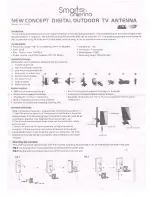
1/4-20 x 5/8”
carriage bolt (4)
through the feed arm of
the back-up/feed support
assy.
1/4-20 hex nut (4)
of the reflector with the
four holes on the back-
up/feed support assy.
bolts through the four
holes on the front of the
reflector. Thread a 1/4-20
hex nut onto each bolt.
Parts
Assembling the Home Digital Satellite Antenna
2
3
4
Insert the four 1/4-
20 x 5/8” carriage
Thread the 50’ RG-6
coaxial cable
Screw the RG-6
coaxial cable onto
6
7
8
Insert the 10-32 x
1-1/4” carriage bolt
Loosen the azimuth
hex nuts on the
5
Connect the LNBF
and feed arm by
1
Line up the four
holes on the back
10-32 flange
hex nut
LNBF
back-up/feed
support assy.
18” reflector
10-32 x 1-1/4”
carriage bolt
holes
holes
hex nuts
hex nuts
coaxial cable
feed arm
through the feed arm.
Then, thread the 10-32
flange hex
nut onto
the bolt.
azimuth
hex nuts
instructions. See page
3 for DISH receiver
setup, or see page 5 for
DIRECTV receiver setup.
Tighten all hex nuts after
pointing the dish.
Continue with the
receiver setup
;
‘;
‘;
‘;
‘;
‘;
‘;
The satellite receiver powers the LNB by sending voltage up the coaxial cable.
Items such as splitters, video switches, and wall plates will stop the satellite signal.
For this reason, it is important to run the coaxial cable directly from the satellite
receiver to the satellite dish/antenna when searching for a signal.
Connect the coaxial cable directly from the satellite antenna to the “Satellite In” port
on the back of the satellite receiver.
Once the satellite antenna has been assembled, the RG-6 coaxial cable now runs through the feed arm of the home
digital satellite antenna. The 50’ RG-6 coaxial cable needs to be connected to the receiver. Connect the coaxial cable
according to the steps below.
Follow the instructions on page 3 to set up a DISH receiver or on page 5 to set up a DIRECTV receiver. If setting up
the satellite antenna and receiver for the first time or if setting up the satellite antenna at a new location, begin with
step one of the receiver setup, and proceed with every step. Consult your receiver manual for additional information
on receiver setup.
“Satellite In” port
pushing the parts
together.
back-up/feed support assy,
and slide the unit onto the
tripod
mast.
the LNBF. The coaxial
cable can be screwed
onto either
port.
50’ RG-6
coaxial cable
feed arm
Connecting to the Receiver
DISH receivers will often not show when they are on signal if they have
incorrect “Check Switch” information. For this reason, DISH users must clear
current settings before pointing. To do this for most DISH receivers, follow
these steps. The following instructions are based on a ViP 211 receiver. Note
that if this is the first time using the receiver, the receiver may automatically
jump to step 4 of the instructions. If your receiver differs from the options
shown, you may need to consult your receiver manual. The wording and
display used in your receiver may differ slightly.
Disclaimer: Receiver setup instructions are accurate at time of printing and may
change without notice. Call Winegard tech line for assistance: 1-800-788-4417.
Check that there
are no checkmarks
by SuperDISH or
Alternate. Select
Test
.
Select option 1,
Point Dish
.
Select
Check
Switch
.
If this is the first
time using your
receiver, your
receiver may
automatically
start with this
step.
Before starting,
disconnect coax
from “Sat in” on
back of receiver.
Press
Menu
on
your remote.
Select option 6,
System Setup
.
Select option 1,
Installation
.
For Help, Call 1-800-788-4417
If so, select
Save
.
It may ask you to
confirm. If so,
select
Save
again.
This should clear
out any previously
installed devices.
Then, select
Done
.
Re-connect the
coaxial cable
to
the “Satellite In”
port on the back
of the receiver.
The receiver will go through a number of steps and then
may warn that fewer satellites were detected.
7
4
5
6
3
1
2
Satellite Antenna with Tripod Kit 3
2 Satellite Antenna with Tripod Kit
DISH Receiver Setup























